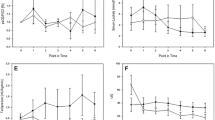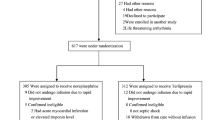Abstract
Objective
To report the effects of terlipressin treatment in four paediatric patients with catecholamine-resistant hypotensive septic shock.
Design and setting
Case report in the pediatric intensive care unit of a university hospital.
Patients
Four children with severe septic shock and hypotension resistant to high doses of norepinephrine and other cathecolamines.
Interventions
Terlipressin was added to the standard treatment, by intravenous bolus at a dose of 0.02 mg/kg every 4 h during a maximum time of 3 days.
Measurement and results
In all cases, terlipressin induced a rapid and sustained improvement in mean arterial pressure, which allowed the lessening or even withdrawal of norepinephrine infusion. No related adverse effects were detected.
Conclusion
Terlipressin might be considered, at least as a rescue therapy, for hypotension resistant to catecholamines in children with septic shock. Further studies are needed to confirm the beneficial effects found in our patients. The optimal administration schedule remains to be elucidated.

Similar content being viewed by others
References
Carcillo JA, Fields AI (2002) Clinical practice parameters for hemodynamic support of pediatric and neonatal patients in septic shock. Crit Care Med 30:1365–1378
Malay MB, Ashton RCJ, Landry DW, Townsend RN (1999) Low-dose vasopressin in the treatment of vasodilatory septic shock. J Trauma 47:699–705
O’Brien A, Clapp L, Singer M (2002) Terlipressin for norepinephrine-resistant septic shock. Lancet 359:1209–1210
Dünser MW, Mayr AJ, Ulmer H, Ritsch N, Knotzer H, Pajk W, Luckner G, Mutz NJ, Hasibeder WR (2001) The effects of vasopressin on systemic hemodynamics in catecholamine-resistant septic and postcardiotomy shock: a retrospective analysis. Anesth Analg 93:7–13
Tsuneyoshi I, Yamada H, Kakihana Y, Nakamura M, Nakano Y, Boyla WA (2001) Hemodynamic metabolic effects of low-dose vasopressin infusions in vasodilatory septic shock. Crit Care Med 29:487–493
Holmes CL, Walley KR, Chittock DR, Lehman T, Russell JA (2001) The effects of vasopressin on hemodynamics and renal function in severe septic shock: a case series. Intensive Care Med 27:1416–1421
Asfar P (2003) Terlipressin in chronic hyperdynamic endotoxic shock: Is it safe? Intensive Care Med 29:154–155
Ioannou G, Doust J, Rockey DC (2003) Terlipressin for acute esophageal variceal hemorrhage (Cochrane Review). Cochrane Database Syst Rev CD002147
Moreau R (2002) Hepatorenal syndrome in patients with cirrhosis. J Gastroenterol Hepatol 17:739–747
Landry D, Oliver J (2001) The pathogenesis of the vasodilatory shock. N Engl J Med 345:588–595
Landry DW, Levin HR, Gallant EM, Ashton RC, Seo S, D’Alesandro D, Oz MC, Oliver JA (1997) Vasopressin deficiency contributes to the vasodilatation of septic shock. Circulation 95:1122–1125
De Keulenaer BL, Stephens DP (2003) Comment on “Terlipressin in chronic hyperdynamic endotoxic shock: Is it safe?” by P. Asfar. Intensive Care Med 29:854
Scharte M, Meyer J, Van Aken H, Bone HG (2001) Hemodynamic effects of terlipressin (a synthetic analog of vasopressin) in healthy and endotoxemic sheep. Crit Care Med 29:1756–1760
Dünser MW, Mayr AJ, Tür A, Pajk W, Barbara F, Knotzer J, Ulmer H, Hasibeder WR (2003) Ischemic skin lesions as a complication of continuous vasopressin infusion in catecholamine-resistant vasodilatory shock: incidence and risk factors. Crit Care Med 31:1394–1398
Westphal M, Bone HG, Van Aken H, Sielenkämper AW (2002) Terlipressin for haemoynamic support in septic patients: a double-edged sword? Lancet 360:1250–1251
Author information
Authors and Affiliations
Corresponding author
Rights and permissions
About this article
Cite this article
Rodríguez-Núñez, A., Fernández-Sanmartín, M., Martinón-Torres, F. et al. Terlipressin for catecholamine-resistant septic shock in children. Intensive Care Med 30, 477–480 (2004). https://doi.org/10.1007/s00134-003-2114-3
Received:
Accepted:
Published:
Issue Date:
DOI: https://doi.org/10.1007/s00134-003-2114-3




